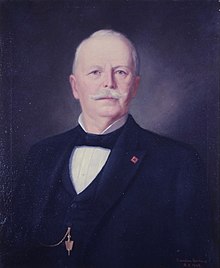fiction.wikisort.org - Writer
Robert Lowry (March 10, 1829 – January 19, 1910) was an American politician and lawyer who served as the 32nd governor of Mississippi from 1882 to 1890. Before entering politics, he was a senior officer of the Confederate States Army who commanded infantry in the Western Theater of the American Civil War.
Robert Lowry | |
|---|---|
 Official portrait, 1905 | |
| 32nd Governor of Mississippi | |
| In office January 2, 1882 – January 13, 1890 | |
| Lieutenant | G. D. Shands |
| Preceded by | John M. Stone |
| Succeeded by | John M. Stone |
| Personal details | |
| Born | March 10, 1829 Chesterfield District, South Carolina, U.S. |
| Died | January 19, 1910 (aged 80) Jackson, Mississippi, U.S. |
| Political party | Democratic |
| Signature | |
| Military service | |
| Allegiance | |
| Branch/service | |
| Years of service | 1861–1865 |
| Rank | |
| Commands | 6th Mississippi Infantry Lowry's Brigade |
| Battles/wars | American Civil War
|
Early life and military service

Robert Lowry was born in Chesterfield District, South Carolina on March 10, 1829,[1] and was raised in Mississippi. During the American Civil War he enlisted as a private in the Confederate States Army. He quickly received a commission in the 6th Mississippi Infantry.[2] He commanded the regiment at the Battle of Shiloh where it which suffered very heavy casualties and he was wounded himself.[3] In early 1864 he led the troops that were sent to put down the local uprising of citizens near Jones County, Mississippi.[4] Later Lowry commanded a brigade of Mississippi regiments in the Third Corps of the Army of Tennessee; an in February 1865 he was finally promoted to brigadier-general. When the war was over, he returned to the practice of law at Brandon. Lowry briefly served in the State senate after the war (1865–1866). Massive fraud in the gubernatorial election of 1881 resulted in the election of the subject over the Independent People's Party candidate, Benjamin King.[5]
Governor (1882–1890)
Between 1882 and 1890 he was the Democratic governor of Mississippi, serving two four-year terms. He could be called a Bourbon Democrat. The Farmers' Alliance movement continued to show local action in Yazoo County and in most areas of the state.[6]
In September 1889, Lowry ordered the state militia to Leflore County, where organizing by the Colored Farmers' Alliance sparked false rumors of an impending Black "uprising." Militia troops killed an estimated 25 Black people.[7]
Political activity related to peonage and racial discrimination in the Mississippi delta and other areas of the state led to violence during his term of office.[8] Rapid industrial development occurred during his administration as well as the founding of the first state-supported women's college at Columbus.[9]
Personal life
Lowry was related to J.A.W. Lowry, a lawyer and politician in Bossier Parish in northwestern Louisiana.[10]
See also
- List of Confederate States Army generals
- List of members of the United Confederate Veterans
References
- Glory in Grey – Volume 2
- Eicher, p. 355.
- Duval, Mary V. (1887). The Students' History of Mississippi. Louisville, KY: The Courier-Journal. p. 203.
- Coppock, Paul R. (February 3, 1980). "Lowry Brand of Bourbon". Commercial-Appeal (Memphis)
- Cresswell, Stephen Edward (1995). Multiparty Politics in Mississippi, 1877–1902. Jackson: University Press of Mississippi. p. 200. ISBN 0878057706.
- (1888 November 15). "Board of Supervisors" Yazoo Sentinel (Yazoo City, MS).
- Holmes, William F. (1973). "The Leflore County Massacre and the Demise of the Colored Farmers' Alliance". Phylon. 34 (3): 267–274. doi:10.2307/274185. ISSN 0031-8906. JSTOR 274185. Retrieved February 22, 2022.
- (1889 September 19)."More Race Troubles". Clarion Ledger(Jackson, MS).
- mshistorynow.mdah.state.ms.us http://mshistorynow.mdah.state.ms.us/articles/265/index.php?s=extra&id=134. Retrieved July 31, 2012.
{{cite web}}: Missing or empty|title=(help) - ""John A. W. Lowry of Bossier Parish, Louisiana" in Biographical and Historical Memoirs of Northwest Louisiana". Chicago and Nashville, Tennessee: Southern Publishing Company. 1890. Retrieved March 23, 2015.
Sources
- Eicher, John H., and David J. Eicher, Civil War High Commands. Stanford: Stanford University Press, 2001. ISBN 978-0-8047-3641-1.
- Sifakis, Stewart. Who Was Who in the Civil War. New York: Facts On File, 1988. ISBN 978-0-8160-1055-4.
- Warner, Ezra J. Generals in Gray: Lives of the Confederate Commanders. Baton Rouge: Louisiana State University Press, 1959. ISBN 978-0-8071-0823-9.
External links
- Robert Lowry at Find a Grave
- Robert Lowry at The Political Graveyard
- Works by or about Robert Lowry at Internet Archive
- Works by or about Robert Lowry in libraries (WorldCat catalog)
Другой контент может иметь иную лицензию. Перед использованием материалов сайта WikiSort.org внимательно изучите правила лицензирования конкретных элементов наполнения сайта.
WikiSort.org - проект по пересортировке и дополнению контента Википедии
